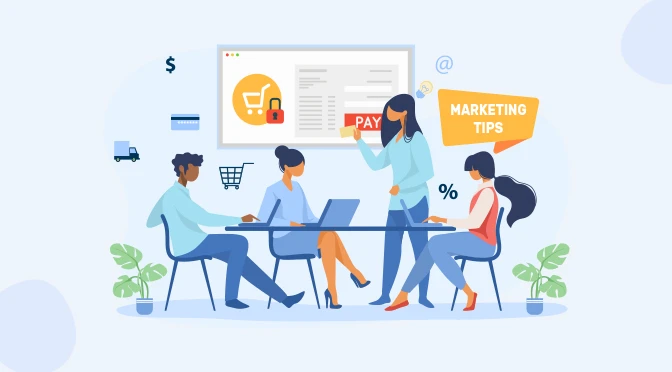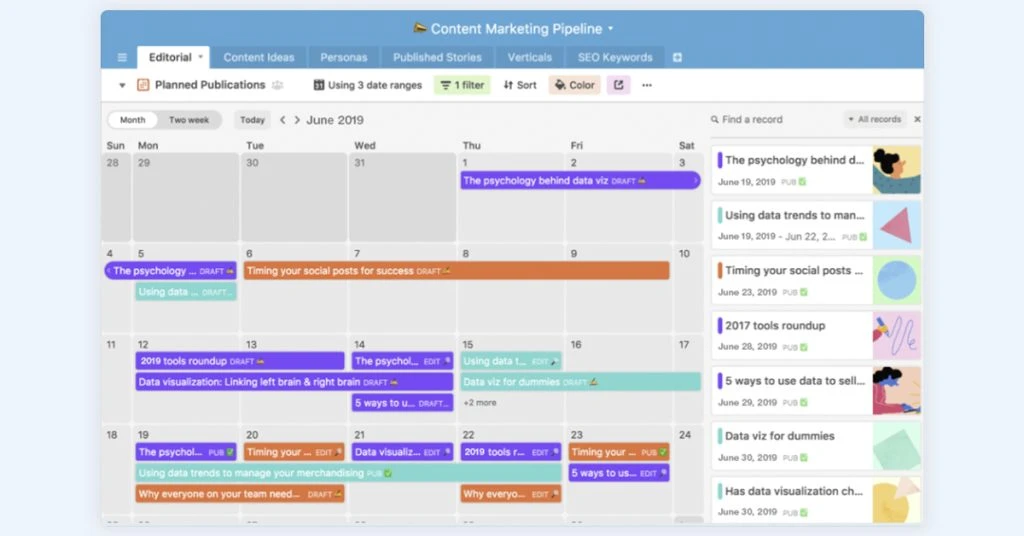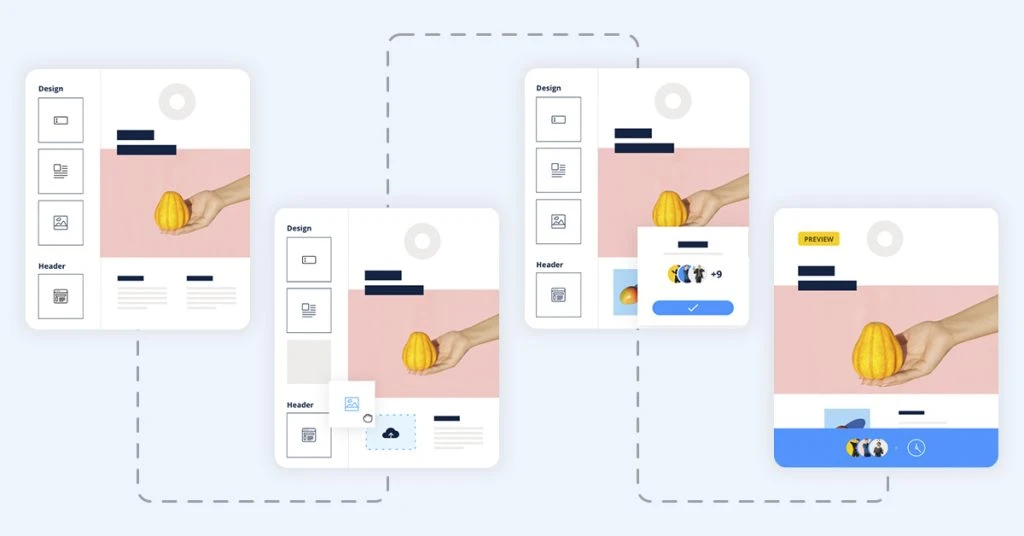Top 10 eCommerce Marketing Tips For New Business Owners

Table of Contents
Ever since the advent of technology, the way businesses are moving has changed drastically. Gone are the days when businesses were limited only to a brick-and-mortar shop.
Today, there are also many businesses sprouting up all over the internet. These are those businesses that have websites and social media sites as their main display center or main store.
This fact is what eCommerce businesses are all about. It’s the act of running a business on the Internet. For most new business owners like yourself, this is also one of the easiest and cheapest to penetrate.
You don’t have to spend so much on capital, and there’s less preparation too, as you don’t need to fix up a physical store. But, this doesn’t mean that the competition is any less. With so many websites around, you can easily create a unique logo using a free logo maker.
Because of its profitability, eCommerce businesses are also selling out like hot pancakes. In fact, a quick browse through social media sites is going to lead you to shops selling all sorts of different things.
Now that you’re a newbie, this means that you’ll also have to catch up. Hence, more effort with your marketing strategies. That way, you can be on par with all the other businesses that have started to operate successfully before you.

Think about your current position right now as a new business owner. Certainly, there’s so much that you can and need to improve on. Because your e-commerce business is still in its infancy stage, you’ll inevitably have to double, even triple time with your marketing strategies.
If so, you’re in the right place. Here, you’ll get ideas regarding the top eCommerce marketing strategies that you can apply:
1. First Understand The Overall Nature Of Ecommerce
As a new business owner, are you a hundred percent sure that you’re well versed with what eCommerce really means? Perhaps not. Don’t worry, as this is normal for beginners.
You’re going to learn as you go. But, it’s also still prudent that before you take it full blast with all of your marketing activities, you already have a pre-noted understanding of the overall nature of e-commerce. That way, you know the type of business industry that you’re trying to fit into.
What is eCommerce marketing? For starters, this refers to the promotional activities that your business is going to undertake to drive more traffic to your online store.
This traffic can then be converted into paying customers, which, hopefully, they also stay and become loyal customers. The more that you’re able to achieve this, then the higher the chances of your online store making it well, profit-wise.
When you think about your marketing strategies, you shouldn’t limit yourself only to your website or social media site per se. A holistic approach will always factor in all of your marketing techniques, both on and off-site.
To help you this early on to learn more about eCommerce, get in touch with experts from the e-commerce development company. This is an agency that can start helping you with e-commerce, marketing, and pertinent matters.
2. Have A Robust Content Marketing Strategy
Before you even start with anything, have a plan. In eCommerce marketing, this plan refers to your content marketing strategy. You can think of it like the foundation of a building, a business plan for a brick-and-mortar business.

Here, you first have to start with all of the methods that you plan to use and incorporate, or the content of your sites and social media pages, for you to reach out to your target market. Content marketing is so effective, such that 60% of B2C marketers are actually committed to content marketing.
With this plan, be sure to check on it regularly, also. As a newbie, you may want to hold meetings once every two weeks, then once a month, then quarterly.
Assess whether or not your content marketing strategies are achieved. Is a blog now in place? Have you sent out newsletters? It’s like making an inventory of the things that you’ll still have to go through to make your foundation stronger.
Here are some of the best content marketing strategies to apply:
Only publish your very best material. Whether you’re aiming for a blog on your site or an infographic, or a vlog, never post anything that’s still mediocre. Make sure that whatever content strategies you apply, these are those that you already consider being your best.
It’s better to have only one post in every week that you know hits the mark, rather than have daily posts that don’t even contribute to your business goals.
Always remember in mind the goal that you’re trying to achieve by posting certain content. For example, with publishing this video this week, what is it that you’re trying to achieve?
Are you trying to sell out your inventory of old stocks by making them more marketable through the video? Having this mind helps you work even further to ensure that your content best serves the desires of your audience.
Check the success of your content through data. Information is key, and data is one of the best assets that you can ever have in e-commerce marketing. After a particular period, make it a point also to evaluate the success of a specific content through data.
For example, use analytics to your advantage. This can help you determine whether or not your content marketing strategies are also working. Plus, it also gives you an overall idea as to the type of content that your customers are looking to read about.
3. Don’t Be Afraid To Upsell Your Products
Upselling your products refers to the process of selling a slightly more premium, bigger, or better product than the one that the customer initially considered to purchase.
In simpler terms, you may have seen this through concrete examples on fast-food chains, for instance, where the food server asks you, “Would you like to upgrade or supersize your soda?”
Doing this is actually a very effective marketing strategy for the business, and it’s no different for you in the e-commerce industry. Upselling works to your advantage because there may be cases when your customers don’t know that a slightly more premium product exists.
It could be because they simply didn’t have the time to scroll through all of your list of products. Perhaps also simply because you’re still a new business, and they’re also still unfamiliar with your business offers.
For example, you’re in the online business of selling leather goods. Customer A has chosen Product X under your bags. But, they don’t know that there’s a slightly better variant than product X, made of better leather, with only a slight difference in price.
Offer this to your customer. Chances are, they may be more than willing to make that upgrade. In doing so, you’re able to effectively increase your profit rating by selling a better product, than maybe the case if you were to convince another customer to buy more.
In upselling, however, take note of the following precautions:
- Don’t upsell products that already have a wide difference in the price, as this may be insensitive to some customers, especially those that are on a budget.
- Make sure that all of your upsells always have a relation to the original product (e.g., bag to bag, shoe to shoe)
4. Have an Email Marketing Strategy
Email marketing refers to the use of electronic mail to promote your goods and services. You have a contact list to follow. On this list, take the time to send regular emails based on the latest products that you may be offering or even promotional newsletters such as items on your inventory that are now on sale.

Who knows, you may have a customer that’s long been wanting to purchase Product Y from your list, but is just waiting it out a bit until it fits their budget. Had you not informed them of this sale through email marketing, they may never know too, that now, they can finally afford to buy that product.
Email marketing is one of the most successful eCommerce marketing strategies that you can apply simply because people are more inclined to open their emails. Most individuals also check their emails every day. So, you’re able to reach out effectively to your customers is as simple as a few clicks.
Related: Best Marketing Strategies to expand and increase your business
For effective email marketing, here are some pointers to remember:
- Always have a killer subject line. When your mail is in the inbox of the receiver, it should be catchy enough for them to open that message.
Else, chances are that they may just delete your message immediately, thinking that it’s spam.
- Always update your subscriber list. This list refers to your list of contacts for you to send the email to. As a new business owner, you may have to exert more effort also in building first a strong subscriber list.
A good way for you to start is to have a pop-up form on your website or your social media account that asks for the email addresses of your subscribers.
- Write for the web. By this, it means that you’re composing emails like as if it’s a web copy or a web post. Don’t fill it up too much with words that look boring and tiring to read through.
Always keep your paragraphs short and break the ideas down into different bullets.
5. Be Present on Instagram
Of all the social media sites on the Internet today, one of the most popular and fastest-growing ones is Instagram. In terms of marketing, it’s also one of the best ways for you to catch the attention of your target market.
In e-commerce marketing, being present on Instagram doesn’t necessarily mean that you also need to sell on Instagram. It involves using this platform to your advantage to market your eCommerce business’ website.

For example, have an Instagram account with a handle that’s also your business name. In your bio section, do include a link to your website. That way, it’s easier for your Instagram followers also to visit your site immediately.

Then, use Instagram through catchy graphics and images to promote new products that you’re selling, items that are on sale, or simply to post announcements.
With the right strategies, you can slowly find your way towards enjoying Instagram to your advantage such that it guides your followers slowly towards the products that you’re selling. Here are some ways to strengthen your Instagram presence:
- Use hashtags.
- Run contests through your Insta Stories.
- Show behind-the-scenes or previews of the products that you’ll soon launch.
6. Use A Personalized Strategy
Having a personalization strategy means that in whatever marketing means you employ for your e-commerce business, you make your customers remember that it’s coming from them.
This means staying away from messages that sound like everyone else or even replying to your customers’ feedback like as if you were just talking with a friend.
The whole idea of employing a personalization strategy in your business is that you make your customers feel more that you’re a human being. Not all customers want to deal with a faceless and robot-like entity.
Also, it’s branding your business as a human being. It helps your customers remember that although you’re a business entity, the people behind your business are humans.
You, the founder itself, is a human being that also has to heart the desires, wants, and needs of your customers.
Having a personalized strategy is actually very beneficial, as nearly 74% of Internet users get annoyed when they’re presented with content that doesn’t fit their personal interests.
Here are some of the effective strategies to employ a personalized approach:
- Address your recipients with their names on emails and even on their orders
- Send out special promo codes to loyal customers on their birthdays, or even start also by greeting your customers on their birthdays
- Send out videos or images of a typical workday in your office and how your team works so hard to develop the best products
7. Reduce The Occurrence Of Abandoned Carts
Abandoned carts refer to the shopping carts of your customers that don’t make it beyond check out. These carts may already have items in it that your customer wants to purchase, but is forced to abandon for any of the following reasons:
- The credit card was declined
- The extra costs were excessive, such as shipping fees
- The preferred payment method of your customer isn’t available
- The customer was forced to create an account
- The return policies weren’t satisfactory
- The checkout process was too complicated
- The delivery period isn’t fast enough
- The website crashed
The negative thing with abandoned carts is that you’re losing money. This could’ve been sales that you would’ve made had the customer not been forced to leave their cart.
In most cases also, without a proper system in place on your website, these abandoned carts are forever lost, meaning there’s no way for your customers to go back to them the next time they shop on your site.
As a new business owner, your marketing goals should also include a system on your web design whereby the customer can go back to a cart that they previously abandoned.
When this option is available, chances are, you’ll have more customers choosing your site over all others when shopping.
A good way for you to start with strategies that reduce the occurrence of abandoned carts is for you to check through the list above also of some of the most common reasons for abandoned carts.
As you make improvements on your business website, do ensure that those reasons are adequately addressed, so that they don’t happen to your site.
8. Always Have Original Content
In eCommerce marketing, content is key. This is what gets your customers interested and convinced in buying your products. But, this content shouldn’t just be any content per se.
Your marketing strategies should also focus on creating original content. This means that whatever content you post, it’s directly related to the niche of your products and services.
Even more importantly, original content creates a better recall in the minds of your customers. This means that whenever they see a graphic, for example, they can instantly associate the style or design with your business.
Here are great tips to help you build original content for your website:
- Consider your audience or your target market. Whenever you create content for your website, keep your audience by asking yourself what information is important to them?
How can you convince your target market that they need to buy your goods and services? Then, draft your content also in a language that’s clear and understandable for your target audience.
- Evoke the emotions of your readers. Have your readers long been struggling with something? Then, here comes your service that can help lift this struggle off their chest?
Be emotional with your content, such that it touches the heartstrings of your customers. Doing this will also show your target customers that they need your services and not that of a close competitor.
- Leverage your mind. You don’t need to be a writing guru for you to post and write excellent content. Share your thoughts and opinions in your own words and terms.
Doing this allows your personality as a human being to shine through. By this, it also increases the chances that there’s no other content on the Internet precisely like yours. After all, no two people are exactly alike.
9. Have User-Generated Content
User-generated content refers to the content on your website, as a part of your e-commerce marketing strategies, that your followers or your loyal customers create. This can refer to anything from infographics, photos, newsletters, blogs, and even videos.
One of the best ways for you to encourage and have user-generated content from time-to-time on your site is to hold contests. For example, ask your followers to post photos of them with hashtags and a caption using any of your products or services then, the best post wins a prize.
This is a very effective eCommerce marketing strategy because you have more people marketing for your business than you would if you were to do it all by yourself.
As a new business owner, you’d know that one of the challenges is always how to get your brand out there to be heard. Plus, it takes away a bulk of effort from your hands for a particular period regarding having to think of marketing content yourself.
Here are other great reasons why user-generated content works:
- It helps your business understand better your customers and the community that they belong to
- It embraces authenticity, as each of these posts by your followers will generally be different from each other
- It helps build trust and reputability for a new brand like yours
- It’s cost-effective, as, for a specific time, you don’t have to do all the marketing efforts by yourself
- It increases customer engagement and retention
10. Build a Facebook Store
If Instagram is a good avenue for you to post updates about your website and your business in general, Facebook is also an excellent place for you to sell more of your products and services.

Over the years, Facebook has also evolved as to its use on the internet. What was once a means to communicate with family and friends on the other end of the globe is now also used for business purposes.
For the latter purpose, it also proved to be profitable. After all, on Facebook, you’ve got a worldwide population all at the tip of your fingers.
Selling your goods and services on Facebook is an excellent way for you, not just to earn more income. But, as a new business owner, it’s also a unique way to have more people learn about your brand’s existence.
Conclusion
Every online store always wants to increase the traffic that’s coming into their site. After all, more traffic also means a higher possibility for more income.
They don’t want to waste whatever opportunity for growth it is that they may have. For a new business owner like yourself, however, this can prove to be a little bit more challenging.
After all, you’re still going to have to penetrate the market and compete as well as all the other businesses are doing. Without which, you’ll also fail to be successful.
You’re in luck as you’ve just read through some of the most insightful tips. Now all you have to do is get started with the dirty work of putting these all into practice.
Author Bio:
Aron is an SEO specialist at First Page Digital Hong Kong. He is in charge of executing search campaigns for clients in the Asia Pacific region. When he isn’t diving into UX or technical audits, he enjoys reading marketing blogs or hiking.

